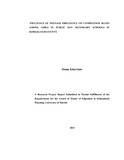| dc.description.abstract | Retention of students from the beginning of their education to completion at any
level is the hallmark and the ultimate goal of any education system in any
country. Compared to boys, girls face numerous hurdles in their pursuit of
education that causes unanticipated school interruptions and the likely eventuality
of school dropout; a phenomenon that affects equitable human capital formation.
Specific to the girl child, is the menace of teenage pregnancy and the associated
secondary school dropout that this study sought to address. The study was guided
by human capital theory. The specific objectives were: to establish the extent to
which individual factors influence teenage pregnancy in public day secondary
schools in Kimilili Sub-County, to examine the extent to which home based
factors influence teenage pregnancy in public day secondary schools in Kimilili
Sub-County, to determine the extent to which school factors influence teenage
pregnancy in public day secondary schools in Kimilili Sub-County and to assess
the extent to which teenage pregnancy influence completion rate of girls in public
day secondary schools Kimilili Sub-County. The study deployed descriptive
survey research design. The accessible population was 300 form four girls, 18
Directors of Study and 1 D. o. E. Stratified random sampling was used to come up
with 90 form four girls from 8 schools and 8 Directors of Study while census
sampling was used to select the D.o.E. The study used questionnaires for students
and Directors of Study and an interview schedule was administered on the Sub
County D.o.E. Validity of the instruments was determined by the researcher who
formulated items according to the research objectives. Experts from the
Department of Educational Administration and Planning verified content validity.
The instruments were piloted in two schools that were excluded in the actual
study and test re-test method was used to calculate reliability. A reliability
coefficient of 0.6 was attained and hence accepted as reliable. Data collected was
analyzed using measures of central tendency. Results were then presented using
tables. The study found out that individual sexual behaviour of students, lack of
strict parental supervision and monitoring, home poverty, poor academic
performance at school, and sexual harassment by both boys and teachers exposed
girls to the problem of teenage pregnancy. The study also established that over
40% of the girls‟ dropout cases were due to teenage pregnancy over the four year
cycle in day secondary schools in Kimilili Sub-County. The study recommended
the creation of clear partnerships between public health facilities and schools to
promote effective utilization of YFRHS, sensitization of parents on their roles,
monitoring of poor academic performers at school and legal prosecution of
teachers found harassing school girls. | en_US |

